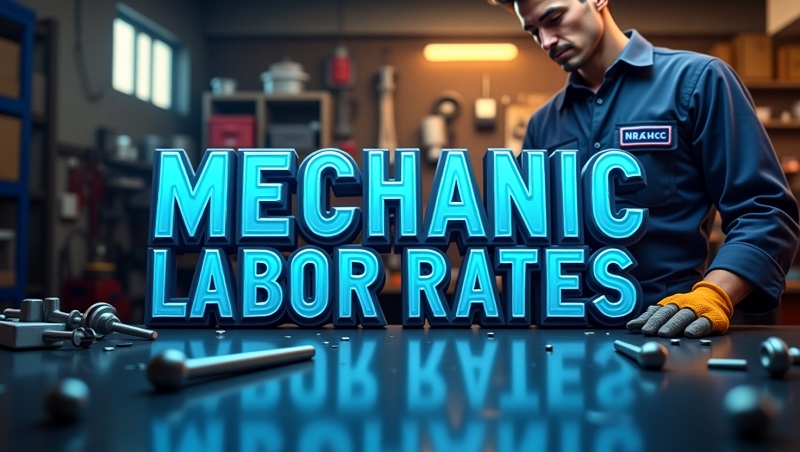When your vehicle breaks down or needs maintenance, one of the first concerns that comes to mind is, “How much is this going to cost me?” While many drivers focus on the price of parts, it’s often the mechanic labor rate that makes up a significant portion of the repair bill—and it’s also the most misunderstood. Whether you’re visiting a local garage, a national chain, or a dealership service center, the labor rate can vary dramatically, leaving many car owners confused or caught off guard. Understanding what mechanic labor rates are, how they’re calculated, and what factors influence them can help you make smarter decisions and avoid unnecessary expenses. In this in-depth guide, we’ll break down everything you need to know about labor charges in the auto repair world—how rates differ, why they fluctuate, and how to ensure you’re paying a fair price. Whether you’re a new driver or a seasoned car owner, this comprehensive overview will give you the knowledge and confidence to handle your next repair shop visit with clarity and control.

What Is a Mechanic Labor Rate?
A mechanic labor rate refers to the hourly fee that an auto repair shop charges for the time a mechanic spends working on your vehicle. It’s typically expressed as a cost per hour, such as $90/hour, $120/hour, or even $200/hour in some high-end markets. This rate covers not only the mechanic’s direct labor but also overhead expenses like shop rent, tools, insurance, utilities, and administrative staff salaries. In essence, the labor rate is what you pay for the time and expertise required to fix your vehicle, above and beyond the cost of the replacement parts. Many car owners assume that labor rates strictly reflect a mechanic’s wage, but that is far from the truth. The mechanic themselves usually earns a portion of that rate, while the remainder covers the shop’s operating expenses and profit margin. Understanding this breakdown can help customers see why labor costs can sometimes seem high.
Types of Labor Rates in Auto Repair
There are typically two types of labor rates you’ll encounter in an auto repair shop: flat-rate and hourly rate. Flat-rate labor charges are based on a standardized time it should take to perform a specific repair. These times are usually sourced from an industry manual such as the Mitchell Labor Guide or Chilton Labor Guide. For instance, if the guide says it should take 2 hours to replace a water pump, you’ll be charged for 2 hours of labor regardless of whether the mechanic completes the job in 90 minutes or 3 hours. This method benefits efficiency and helps shops maintain consistent pricing. The hourly labor rate, on the other hand, means you are charged based on the actual time it takes the mechanic to complete the job. While this can seem more fair in some cases, it also opens the door to variability and potential overcharging if the mechanic is inefficient or inexperienced. Some shops might even combine both methods, charging flat rates for common repairs and hourly rates for complex diagnostics or custom work.
National Average Mechanic Labor Rates
Mechanic labor rates vary widely across the United States depending on factors such as location, the type of repair shop, and even the complexity of the job. On average, labor rates in 2025 range from $75 to $160 per hour, with luxury dealerships and shops in metropolitan areas charging upwards of $200 per hour. For example, in rural areas or small towns, a local independent repair shop might charge around $85/hour, while in larger cities like Los Angeles, Chicago, or New York, the same repair could cost you $150/hour or more. Dealerships tend to have the highest rates, not necessarily because their service is better, but because they have more overhead, brand certification requirements, and modern diagnostic tools.
Factors That Affect Mechanic Labor Rates
Several factors influence how much you’ll pay for auto repair labor. First, location plays a big role. Labor costs are naturally higher in regions with a higher cost of living. For example, a shop in California or New York will have to pay more for rent, employee wages, and taxes, which translates into a higher labor rate. Second, the type of repair facility also matters. Dealerships tend to be more expensive than independent mechanics, and national chain shops like Midas, Firestone, or Pep Boys often fall somewhere in between. The type of vehicle you drive also affects labor costs. Foreign cars, luxury vehicles, or hybrid/electric vehicles often require specialized tools or training, which can increase the rate. Additionally, the complexity of the repair and the availability of parts also contribute to the final labor bill. Finally, certifications held by the shop, such as ASE (Automotive Service Excellence), often justify higher rates due to perceived expertise and trustworthiness.
Diagnostic Fees and Hidden Labor Charges
In many cases, shops charge a diagnostic fee in addition to their labor rate. This fee, usually ranging between $80 and $150, is used to cover the time it takes to figure out what’s wrong with your car. Some shops will waive this fee if you go ahead with the repair, but not always. It’s important to ask upfront whether the diagnostic fee will be credited toward the final bill. Furthermore, be cautious of hidden labor charges. Some shops itemize labor by listing it separately for each repair operation, even if several parts are replaced in one area of the vehicle. For example, a shop might charge separate labor fees for replacing a serpentine belt and a water pump, even though both parts require removal of the same components. A reputable shop will combine such tasks under one labor charge or discount the labor for overlapping work.
How to Check if a Mechanic Labor Rate Is Fair
Before agreeing to any repair, it’s a good idea to get multiple quotes. Ask at least two or three shops to give you an estimate for the same repair and compare the labor rates. Don’t be afraid to ask how they calculate their rates—are they flat-rate or hourly, and do they follow any labor time guide? You can also do some research online by visiting car repair cost estimators like RepairPal or YourMechanic, which offer national and local labor rate averages for various services. Another good practice is to read customer reviews. If a shop consistently receives complaints about overcharging or unclear billing, consider it a red flag. Trustworthy mechanics will explain their labor charges clearly, provide written estimates, and notify you before performing any additional work.
Why Dealership Labor Rates Are Higher
If you’ve ever taken your car to a dealership for repairs, you’ve probably noticed the labor rates are significantly higher than at an independent shop. This isn’t just a coincidence. Dealerships have to invest heavily in brand-specific tools, training, and certifications. Their technicians are often factory-trained to work on specific makes and models, which is a big selling point but also adds to the cost. Dealerships also have a lot more overhead, including high-end facilities, waiting lounges, customer shuttle services, and warranty processing departments. All these amenities are baked into the higher labor rate. While dealership service may seem more “official,” independent shops can offer comparable quality at a much lower cost—especially if they have ASE-certified mechanics and positive reviews.
The Future of Mechanic Labor Rates: EVs and Automation
As electric vehicles (EVs) become more common, mechanic labor rates are expected to change. EVs require less routine maintenance—no oil changes, fewer moving parts—but they require high-voltage safety training and specialized knowledge, which may drive up labor rates for electric car repairs. In fact, not all repair shops are equipped or certified to handle EVs yet, which could create labor scarcity and further push up rates. Similarly, with the increasing use of diagnostic software, automation, and AI tools in the automotive repair industry, some tasks that once took hours can now be completed in minutes. This could reduce labor time, but not necessarily labor rates. In many cases, shops may maintain higher rates to cover the cost of purchasing and maintaining advanced diagnostic equipment.
Tips to Save on Mechanic Labor Costs
If you want to save money on mechanic labor, here are some practical tips. First, try to perform basic maintenance yourself. Tasks like changing wiper blades, replacing air filters, or installing new spark plugs can often be done with minimal tools and knowledge. Second, build a relationship with a trusted local mechanic. Regular customers may receive better pricing or labor discounts. Third, always ask for a written estimate and breakdown of parts vs. labor before authorizing repairs. This ensures transparency and helps avoid surprise charges. Also, consider providing your own parts if the shop allows it—buying OEM parts online can be cheaper than what the shop charges. Just make sure the shop is okay with it and that the warranty still applies.
Conclusion: Making Sense of Mechanic Labor Rates
Understanding mechanic labor rates is essential for any vehicle owner looking to make informed, cost-effective decisions about car repairs. While it’s easy to feel overwhelmed by the numbers on a repair bill, knowing what influences those labor costs—such as shop type, location, vehicle complexity, and repair method—can help you better navigate the process. Whether you choose a dealership, a chain repair shop, or an independent mechanic, being aware of how labor is calculated gives you the power to ask the right questions, compare quotes confidently, and avoid hidden charges. As the automotive industry evolves with electric vehicles and digital diagnostics, labor rates may continue to shift, but transparency, trust, and expertise will always remain key. By doing your research, seeking clarity, and building a relationship with a reliable mechanic, you not only protect your wallet but also ensure your vehicle receives the quality care it deserves.
FAQs
1. What is the average mechanic labor rate in the U.S. in 2025?
The average mechanic labor rate in 2025 ranges from $75 to $160 per hour, depending on location, type of shop, and complexity of the repair.
2. Why do dealership mechanics charge more for labor?
Dealerships charge more due to higher overhead costs, factory-trained technicians, and specialized tools required for brand-specific repairs.
3. Is it cheaper to go to an independent mechanic?
Yes, independent mechanics usually offer lower labor rates compared to dealerships and can provide comparable service quality if certified and well-reviewed.
4. What’s the difference between flat-rate and hourly labor?
Flat-rate labor is based on estimated time from a guidebook, while hourly labor is based on actual time spent by the mechanic on the job.
5. Can I negotiate a mechanic’s labor rate?
You can’t usually negotiate the hourly rate, but you may be able to negotiate discounts, labor bundling, or avoid extra diagnostic charges if you’re a regular customer.


